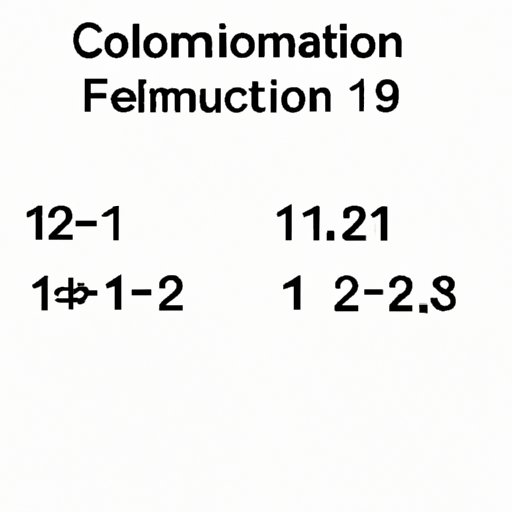
I. Introduction
Understanding how to find a common denominator is an essential skill in mathematics. It is especially important when working with fractions, as it allows us to add or subtract them easily. In this article, we will explore the concept of finding a common denominator and provide tips and tricks to help you master this skill.
II. Getting the Basics Right: A Beginner’s Guide to Finding a Common Denominator
A common denominator is a number that can be divided evenly by the denominators of all the fractions in a problem. When the fractions have a common denominator, it becomes easier to compare them. Finding common denominators also makes it easier to add or subtract fractions with ease.
For example, suppose you have to add 3/4 and 2/3. Both fractions have different denominators, which makes them difficult to add. However, if you find the common denominator, which in this case is 12, adding them becomes straightforward. When you convert 3/4 and 2/3 to fractions with a common denominator of 12, the result is 9/12 and 8/12, respectively. Then, adding these two fractions becomes much easier because they have the same denominator.
III. Mastering the Math: Tips and Tricks for Finding Common Denominators
When finding common denominators with larger and more complex fractions, you need to use certain methods. Many different methods can be used to find common denominators, such as the Least Common Multiple (LCM) method or the method of listing multiples.
The LCM method is especially useful when dealing with larger numbers or complex fractions. To use this method, determine the LCM of the denominators in the fractions you are working with. The LCM is the smallest number that is evenly divisible by all the denominators. Convert each fraction to an equivalent fraction with the LCM as the denominator, and then apply the relevant operations.
Another common method is the method of listing multiples. This works best with smaller fractions. List the multiples of each denominator until you find a number that is common to both denominators. Once this is found, use it as the common denominator and convert the fractions accordingly.
IV. Demystifying the Denominator: A Step-by-Step Guide to Finding a Common Denominator
Here is a step-by-step guide on how to find a common denominator:
- Identify the denominators in the fractions you are working with.
- Find the LCM of the denominators.
- Convert each fraction to an equivalent fraction with the LCM as the denominator.
- Perform the necessary operation(s).
- Simplify the final answer, if possible.
For example, suppose you have to add 1/3 and 5/6.
- The denominators are 3 and 6.
- The LCM of 3 and 6 is 6.
- Convert 1/3 to an equivalent fraction with a denominator of 6, which becomes 2/6. Convert 5/6 to an equivalent fraction with a denominator of 6, which remains 5/6.
- Add 2/6 and 5/6, which gives 7/6.
- Simplify the final answer, which becomes 1 1/6.
V. Your Ultimate Guide to Finding Common Denominators: Strategies and Techniques Unveiled
In addition to the common methods for finding common denominators, there are some lesser-known strategies and techniques that can come in handy in specific situations.
One such technique involves using prime factorization to find common denominators. To use this method, find the prime factors of each denominator. Then, multiply the highest powers of all the common prime factors. The result is the LCM, which can be used as the common denominator. Convert each fraction to an equivalent fraction with the LCM as the denominator, and then perform the relevant operations.
Another technique involves converting the fractions to decimals and finding the greatest common factor of the denominators. Then, multiply both fractions by a power of ten that converts the decimals to whole numbers. Finally, perform the necessary operation(s) on the whole numbers, and then convert the result back to a fraction.
VI. Making the Math Easier: Simplifying the Process of Finding Common Denominators
Although finding common denominators is a simple process, it can be prone to errors. One of the most common mistakes is not reducing fractions to their simplest form before finding a common denominator. It is essential to reduce all fractions to their simplest form before finding the LCM.
Another common mistake is not checking the answer or solution after performing the relevant operations. It is always important to review your work to ensure its accuracy and identify any errors.
To simplify the process of finding common denominators, always start by identifying the denominators. Next, use the most appropriate method to find the common denominator. Finally, perform the relevant operations on the fractions and simplify the final answer if possible.
VII. Conclusion
In conclusion, finding common denominators is an essential skill in mathematics, especially when dealing with fractions. The LCM method and the method of listing multiples are the most common methods to find a common denominator. Still, other techniques such as prime factorization can also be used successfully in specific situations. Always double-check your work to avoid common mistakes such as forgetting to simplify fractions or to check your answer. Practice and apply the tips and tricks we have provided to master the art of finding common denominators.




